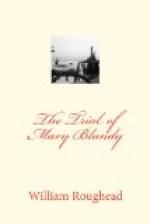How far matters went at this time we do not know, for Cranstoun left Henley in the autumn and did not revisit “The Paradise” till the following summer. Meanwhile Captain D—— returned from abroad, but unaccountably failed to communicate with the girl he had the year before so reluctantly left behind him. Mary’s uncles, “desirous of renewing a courtship which they thought would turn much to the honour and benefit of their niece,” intervened; but Captain D——, though “polite and candid,” declined to renew his pretensions, and the affair fell through. Whether or not he had heard anything of the Cranstoun business does not appear.
According to Miss Blandy’s Own Account, it was not until their second meeting at Lord Mark Kerr’s in the summer of 1747 that the patrician but unattractive Cranstoun declared his passion. She also states that in doing so he referred to an illicit entanglement with a Scottish lady, falsely claiming to be his wedded wife, and that she (Mary) accepted him provisionally, “till the invalidity of the pretended marriage appeared to the whole world.” But here, as we shall presently see, the fair authoress rather antedates the fact. Next day Cranstoun, formally proposing to the old folks for their daughter’s hand, was received by them literally with open arms, henceforth to be treated as a son; and when, after a six weeks’ visit to Bath in company with his gouty kinsman, the captain returned to Henley, it was as the guest of his future father-in-law, of whose “pious fraud” in the matter of the L10,000 dowry; despite his shrewdness, he was unaware. Though the sycophantic attorney would probably as lief have housed a monkey of lineage so distinguished, old Mrs. Blandy seems really to have adored the foxy little captain for his beaux yeux. Doubtless he fooled the dame to the top of her bent. For a time things went pleasantly enough in the old house by the bridge. The town-clerk boasted of his noble quarry, the mother enjoyed for the first time the company and conversation of a man of fashion, and Mary renewed amid the Henley meadows those paradisiacal experiences which formerly she had shared with faithless Captain D——. But once more her happiness received an unexpected check. Lord Mark Kerr, a soldier and a gentleman, becoming aware of the footing upon which his graceless grand-nephew was enjoying the Blandys’ hospitality, wrote to the attorney the amazing news that his daughter’s lover already had a wife and child living in Scotland.
The facts, so far as we know them, were these. On 22nd May, 1744, William Henry Cranstoun was privately married at Edinburgh to Anne, daughter of David Murray, merchant in Leith, a son of the late Sir David Murray of Stanhope, Baronet. As the lady and her family were Jacobite and Roman Catholic, the fact of the marriage was not published at the time for fear of prejudicing the gallant bridegroom’s chances of promotion. The couple lived together “in




